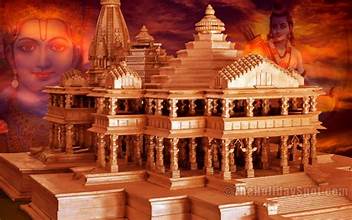The Ram Temple in Ayodhya, a monumental structure of faith and devotion, stands tall as a testament to India’s rich cultural heritage and architectural ingenuity. Following the green signal from the Supreme Court, the construction of this grand temple commenced, and now it graces Ayodhya in its full splendor. The temple is set to host a significant event on January 22nd, with the consecration of the deity, Ram Lalla, in its hallowed premises, an event that will witness the presence of Prime Minister Narendra Modi.
The Grandeur of Ram Temple: A Sight to Behold
The Ram Temple’s grandeur is such that it leaves onlookers in awe. It is adorned with a variety of intricate artworks and sculptures. The walls of the temple are embellished with carvings of various deities, showcasing the exquisite craftsmanship. Additionally, the temple boasts the use of Makrana marble, renowned for its purity and durability, adding to the temple’s majestic appearance.
The Doors of Divinity: Craftsmanship in Ram Temple
A remarkable feature of the Ram Temple is its doors, numbering a total of 46. Among these, 14 doors are exceptionally crafted with gold plating, featuring intricate designs. These doors, made of teak wood, are known for their durability and resistance to wear and tear, making them a fitting choice for the temple’s enduring structure. Teak wood is highly valued, with prices ranging from 50,000 to 100,000 INR per cubic meter.
The Forest Research Institute in Dehradun played a pivotal role in this choice, recommending teak wood for its strength and longevity. After thorough consideration, Maharashtra’s teak wood was chosen for the temple doors, underscoring the commitment to quality and sustainability in the temple’s construction.
A Blend of Spirituality and Architectural Brilliance
The Ram Temple is not just a place of worship but a symbol of India’s deep-rooted spirituality intertwined with architectural excellence. Every element of the temple, from its lofty doors to the finely carved sculptures and the use of pristine Makrana marble, speaks volumes of the meticulous planning and devotion poured into its creation. This temple is a confluence of tradition, art, and devotion, making it a landmark not just in Ayodhya but in the annals of world architecture.
A Cultural Renaissance Through Architecture
The Ram Temple stands as a beacon of India’s cultural renaissance, showcasing the country’s ability to blend traditional architectural practices with modern construction techniques. It is a source of pride and spirituality for many, drawing visitors from across the globe to witness its grandeur and the rich stories embedded within its walls. The temple transcends religious boundaries, emerging as a symbol of unity and artistic prowess.
The Timeless Legacy of the Ram Temple
The Ram Temple in Ayodhya is more than just a structure; it’s a living testament to India’s enduring faith and its rich cultural tapestry. It’s a monument that not only encapsulates the essence of spiritual devotion but also stands as a monument to human ingenuity in architecture and art. As it opens its doors to devotees and admirers alike, the Ram Temple continues to be a symbol of India’s timeless legacy and a beacon of hope and unity in a diverse world.




